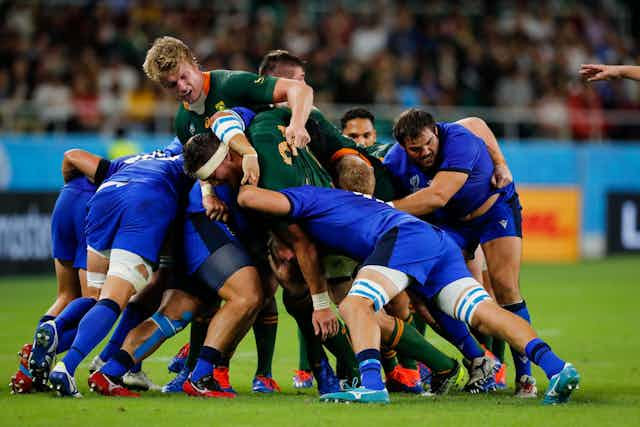Rugby is a physically intense contact sport which requires player to gain field territory to score points. Players can use physical contact, in the form of tackles, to impede the progression of the ball carrier from the opposing team. Due to the physical nature of the sport, teams regularly select players of larger body stature and mass.
It’s not just rugby, predictors based on human form are fundamental to sport success. Sports can be recognised as a Darwinian system that selects specific physical traits which directly relate to performance. Regardless of sporting code, athletes are becoming taller and heavier. For example, the body stature and mass of Olympians have drastically increased since the inception of the modern games. This trend is particularly evident in rugby. Since the 1987 tournament players have become heavier by 6.3 kg. Moreover, heavier teams appear to have greater success at the Rugby World Cup.
Rugby is played by over 8.5 million people in 121 different countries. Every year Northern and Southern hemisphere teams contest for the top slot in the rankings. Currently, New Zealand is ranked as the number one team.
The ultimate prize for rugby teams is to win the World Cup series which reaches its denouement this weekend. Teams, fans and the media are undoubtedly looking for any distinguishing factors, one being body mass, especially in the scrum. The question is, does greater pack mass predict performance?
Since the inception of professional era , rugby players have seen an increase in body stature and mass at a disproportional rate to the general population. This may reflect selection pressures from the physical demands of rugby at the highest playing levels. Indeed, taller and heavier teams have been associated with success.
The focus on body size in rugby is most apparent in the forwards, when scrummaging. A scrum is composed of eight opposing forwards who bind together and in a coordinated manner contest for ball possession. Scrum dominance is essential to a team’s match performance.
The issue is particularly pertinent in this World Cup because Japan has reached the quarter finals of the Rugby World Cup. The team will face South Africa in what is Japan’s first-ever knockout game in a world cup tournament.
Will greater pack mass predict performance in the game?
In 2003, Japan was the lightest and shorted team in the competition. That year Japan did not win a game. In contrast, finalists Australia fielded the heaviest and tallest team of the competition (on average 10kg heavier and 6cm taller than Japan).
This time round the South African team will be on average 5kg heavier and 6cm taller than the Japanese team. But, from the masses reported it seems that on average no team has a distinct physical advantage.
What’s important to remember is that when scrums are contested, masses may not be the only discriminating feature. Rather scrum outcomes, at the professional level, are largely determined by technical skill, team coordination and partially influenced by referees.
This means that the likelihood of winning rests more with fitness and skill, and those indeterminant factors such as player experience, team spirit, grit – and the calls made, or not made, by the referee.

Conflicting views on pack mass in scrums
Teams with dominant scrums are more likely to be awarded scrum-related penalties, affording the teams a potential gain in territory or points. Moreover, teams with higher successful scrums are more likely to win tournaments.
A frequently used metric of scrummaging performance is the total pack mass of a team. However, there are conflicting reports regarding the relationship between body mass and scrum performance (maximal horizontal forces) in rugby players.
The premise for using pack mass as an indicator of scrum dominance is twofold.
Firstly, heavier teams are expected to produce more muscular power and force.
Secondly, heavier teams would have a higher inertia which their opponents would need to overcome. But inertia is a double edged sword. If players have a high body fat percentage, their inertia will increase, but that fat mass would not actively contribute to scrum performance. That’s why players are encouraged to minimise fat mass.
It therefore seems that scrum performance at the professional level may not be exclusively dependent on mass. Teams regularly field players of similar body masses.
Thus, scrummaging performance may be a result of different scrummaging techniques used by teams to achieve their maximal scrummaging forces.

Historically, a number of catastrophic neck and spinal injuries resulted from scrummaging, most stemming from scrums collapses. In response, World Rugby has made a series of rule changes which govern scrum contests, and particularly methods of front row engagement. As a result, referees will closely adjudicate scrums in an attempt to reduce the chance of head and neck injuries.
However, in contrast to popular opinion, the introduction of these new law has not diminished the scrum contest. The contest has remained fair, although it is still open to technical manipulation by the two teams, as they attempt to gain an advantage.

